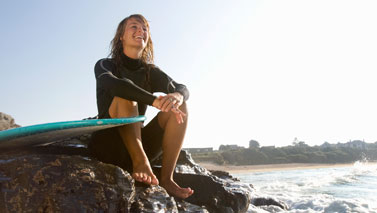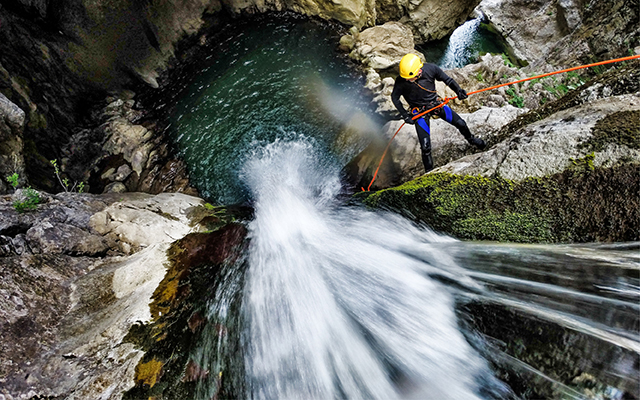“Pop up now!” shouted the surf instructor.
As a 2-foot wave swelled beneath Katherine Flesher’s surfboard, she pushed up with her arms, threw her left foot forward, wobbled, and then stabilized herself in a more-or-less upright position on the board. Riding the foamy whitewater for a few seconds, she whooped with delight before tumbling into Costa Rica’s Pacific surf.
“I couldn’t believe it,” the 42-year-old Minneapolis-based acupuncturist says, recalling her first-ever surf lesson last year. “I stood up on my board during my first hour in the water — something I never, ever expected.”
Flesher had fantasized for years about trying surfing, but during most of her family’s Costa Rica vacation, she hadn’t quite been able to summon the nerve. Whenever the thought popped into her head, she made excuses: “Surfing is for kids,” “I’m not athletic enough,” “I don’t really want to do this crazy, scary thing.”
Toward the trip’s end, though, Flesher gave in to her sense of adventure and signed up for a lesson with a surf instructor. Once she was in the water, her reticence evaporated. “I was too busy remembering what the teacher taught us to be scared,” she says. “It didn’t matter that I was getting knocked over by waves because I was having so much fun.”
There’s no doubt that surfing can bring up powerful fears in most people: of sharks, drowning, falling, cold water and failure. Yet taking the plunge yields rewards in and out of the water, including physical strength, mental focus and emotional triumph.
Renting a board and flailing around in dangerous water alone is not the best way to embark on a potentially transformative experience, though. Especially when skilled and affordable instructors are standing by to help.
Surf schools, which typically offer a 1:3 instructor-to-student ratio, are a great way to access quality instruction for a good price. For the truly terrified, it might be worth scheduling a solo lesson for your first time out.
The following three spots are ideal for surfers at all levels, especially those beginners who are equally intimidated and enthralled by the prospect. Schools are particularly good for traveling beginners, since they provide a surfboard, a leash (to keep the board from getting away) and even a wetsuit. All students need are bathing suits, sunscreen, rash guards and a willingness to challenge themselves.
Easing In: Sayulita, Mexico
Being There: This laid-back town with old-Mexico charm is just 35 minutes from Puerto Vallarta’s airport. Accommodations include family-owned hotels, five-star hotel chains and vacation condo rentals.
“There’s no better place to learn to surf than Sayulita,” says Mark Johnson, a retired mechanic from Las Vegas. He speaks from experience: Years ago he tried surfing in Hawaii and didn’t like it. “The waves were brutal and the instructor wasn’t personable. I struggled all day and figured surfing was only fun for people who were good at it.”
But on vacation in Mexico last year, Johnson eyed the beginning surfers and their instructors having a good time, and he decided to give surfing another try.
“My only apprehension was my back,” the 55-year-old says. Having undergone several surgeries, he was cautious, but the sandy beach and shallow water looked tame. The Sayulita Surf Camps instructor suggested modifications to protect his back. After a handful of attempts, Johnson stood up on the whitewash of a small wave.
“I thought, ‘Wow, I’m up!’ And then, of course, I wiped out,” he says. “Balancing on the board is like walking on ice in cowboy boots.”
The former skeptic was converted, however. Unlike the teachers he encountered in Hawaii, the Sayulita instructors taught in beginner-friendly conditions: small waves far from the rougher, intimidating areas favored by the hotshot surfers. After two lessons, Johnson felt confident enough to try more difficult chop. And he’s already planning his next Sayulita vacation, where he intends to build on his new skills.
Javier Chavez, founder of Wildmex Adventures, a Sayulita surf and adventure company, relates to beginners like Johnson, and emphasizes that teaching safety is an essential first step. A two-hour Wildmex surf lesson begins with a 20-minute primer on wave behavior, popping into stand-up position and steady board stance. After the land lesson, instructors and students paddle into chest-high water so students can learn to “read” the 1- to 3-foot waves.
“We teach you how to fall so you don’t get hurt,” says Chavez. The method? “Spread your arms like a starfish and fall to the side of your board.”
Some bang-ups inevitably happen, so Wildmex starts beginners on rubber-covered boards to soften the impact of rough encounters.
Chavez estimates 90 percent of students stand up during their first lesson. “My clients get so excited on a 2-foot wave,” Chavez says. “It’s not the size of the wave that counts, but the fun you have surfing it.”
Surf With:
- Sayulita Surf Camps. One-day surf camp: $55–$95. Three-, five- and seven-day camps (hotel extra): $200–$550. www.sayulitasurfcamps.com
- Wildmex Adventures. Two-hour lessons: $40–$55 (private). Weeklong Surf and Stay packages: $725–$1,680. www.wildmex.com
Pura Vida: Nosara, Costa Rica
Being There: Nosara is 30 miles off the paved road on western Costa Rica’s Nicoya Peninsula. The beach is unmarred by development. Hotels in this yoga and wellness community range from basic cabanas to luxurious eco-resorts.
Surfing may be an adrenaline sport, but it has its spiritual aspects. Many experienced surfers describe being so attuned to the ocean’s rhythms that they become one with the wave. In Nosara, Costa Rica, blissful experiences are a fairly normal aspect of pura vida, or “pure life,” a healthy-living philosophy espoused by native Costa Ricans who conduct simple, unhurried lives.
“Pura vida is about actively pursuing what brings you happiness,” explains Craig Weller, 29, a Denver-based nutrition coach. “When I’m in Nosara, I live by the tides, and surf when the waves are best. Other than that, I just eat, sleep and read.”
Although Weller has surfed worldwide, he says he “never did it well” until he took a series of four lessons with Nosara Tico Surf School, where instructors helped him refine his technique and taught him their philosophy of living. Weller, who now surfs in Nosara at least once a year, believes that surfing’s ultimate lesson is that it teaches you how to be present. “There are moments of total flow on a wave when you feel complete joy,” he says.
Though Nosara is popular with advanced surfers, it’s also a great place for beginners to get their feet wet in a relaxed atmosphere. “You don’t need to be able to deadlift 500 pounds,” Weller says. “Being reasonably fit with a normal strength-to-body-weight ratio is fine.”
Despite the sport’s muscle-man image, today many attendees at surf lessons and camps are women — sometimes exclusively. Nosara’s Women’s Surf Adventures offers both single lessons and all-inclusive, all-female surf-camp packages. Each has advantages, but for total immersion and camaraderie, camps are a good choice.
“Camps allow your skills to progress faster and help you get into the surfing groove better than an isolated lesson here and there,” says instructor Kimber Kinley. “There’s so much a beginner needs to learn, and it takes time to absorb it all.”
Kinley, who also teaches yoga, starts each morning’s surf lesson on Nosara’s golden sand with pranayama breathing and asanas. She believes yoga helps prepare for the waves. “Both yoga and surfing increase our mind-body connection, which in turn improves coordination, strength, mental focus, breath, balance, and sensing how to move the body,” she says. “The more you practice, the more you trust yourself, which is vital in surfing.”
Surf with:
- Nosara Tico Surf School. 90-minute group lesson: $45/person. Four- to 12-day surf-lesson group packages: $150–$420. www.nosara-surf-school.com
- Women’s Surf Adventures. Weeklong surf camp: $1,970–$4,375. www.womenssurfadventures.com
Ocean Wisdom: San Diego
Being There: San Diego’s beaches make surfing convenient. If you’re traveling on business, you can attend a morning meeting and take a surf lesson that afternoon.
Every surfer deals with fear, whether he’s haunted by scenes from Jaws or has a terror of drowning. So if nerves hold you back in any realm, on the water or at the office, even a one-time surf lesson can be a proving ground that boosts self-confidence.
Conventional surf schools abound in San Diego, but for those dealing with a really troubling level of anxiety, surf instructor Jason Weber also offers “ocean therapy” on northern San Diego County beaches. He uses mind-body techniques like visualization, EFT, anchoring and affirmations to help clients overcome their fears and feel empowered.
“I don’t heal anybody — they do their own healing,” Weber says. “I just show them the way and provide some useful tools.”
Los Angeles psychotherapist and surfer Erin Foster, PhD, wiped out six years ago; she was held down by wave after wave with barely a second to gasp for air between each. Although Foster, now 36, got back on the board, her near-drowning encounter kept her from surfing to her potential for years. “I’d sit on the beach when the conditions were good but the waves were bigger than I was comfortable with,” she says.
Then Foster signed up for three sessions with Weber. “It was strange to be on ‘the other side of the couch,’” she says, “but Jason helped me regain confidence in my surf skills.”
Trauma can get locked in at the cellular level so the body has a physical “memory” of the experience, Foster explains. To help shift her body’s trigger response, Weber stood next to Foster while she let small swells pick her up and roll her underwater. He also taught her to smile while floating in the water to help reprogram her body’s physiological response.
Foster continues to integrate the visualizations she learned from Weber and has fully recovered her pleasure in surfing. “Now I ride the waves with the same joy that brought me to the sport in the first place.”
Surf With:
- Jason’s Surf Lessons & Ocean Therapy. Two-hour private session: $80–$100. www.jasonssurfandtherapy.com




This Post Has 0 Comments